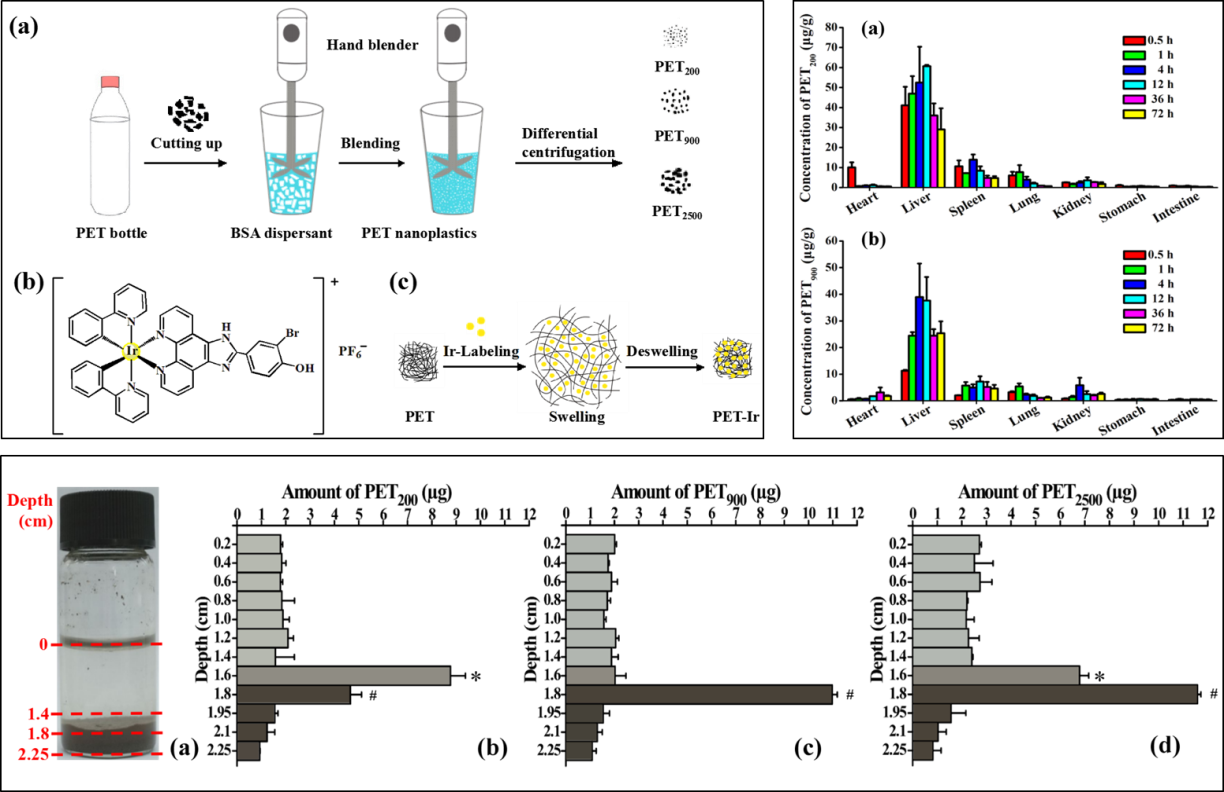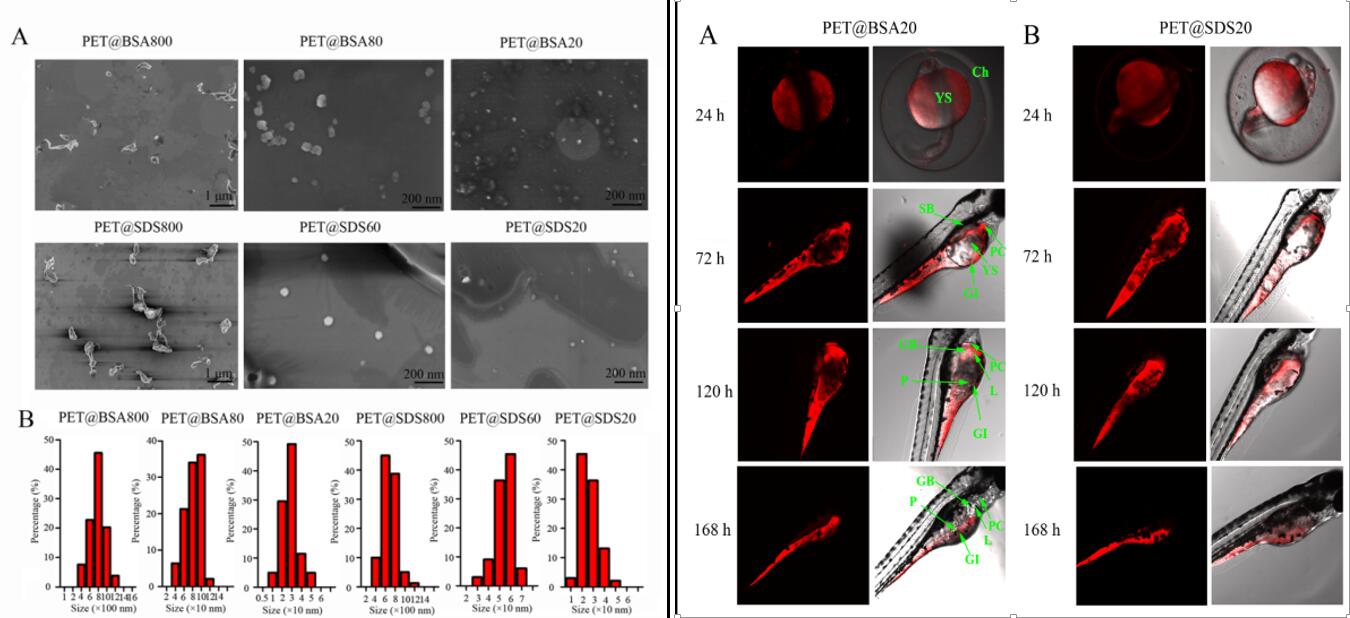| Research |
| Location:Home > Research > Research Progress |
| New progress in preparation, analysis and biological effects investigation of realistic nanoplastics |
In recent years, micro/nanoplastics as emerging pollutants have been widely concerned by the public and scientists. Compared with microplastics, nanoplastics (size less than 1 μ m) have larger concentration in number, higher adsorption efficiency towards organic compounds and stronger ability to cross biological barriers, which may show stronger ecological and toxic effects as consequences. At present, the preparation of nanoplastic samples with real environmental relevance and the highly sensitive tracking technology of nanoplastics in complex matrices are the bottleneck problems. The research group of Yunqing Wang and Lingxin Chen at Yantai Institute of Coastal Zone Research has developed new protocols trying to resolve these challenging issues. 1. Preparation, labeling and quantitative analysis of "realistic" nanoplastic samples. Chemically synthesized polystyrene (PS) nanospheres are popular models in the research of nanoplastics, however, they lack environmental relevance in terms of plastic-type diversity, formation pathways and physical/chemical properties. Herein, improved nanoplastic models were prepared using daily plastic products as raw materials and simulating the mechanical friction pathway in the environment. Nanoplastics of various material types such as polyethylene (PE), polyethylene terephthalate (PET), polypropylene (PP) and polyvinyl chloride (PVC), were prepared by chicken blender grinding and differential centrifugation, which provided a "sample library" for the research of nanoplastics. A new method for the tracking of nanoplastics was further developed based on iridium-containing organic molecular markers and inductively coupled plasma mass spectrometry (ICP-MS) (Figure 1). The migration behavior of PET nanoplastics (prepared from mineral water bottles) in mice and coastal sediments was studied quantitatively. The results showed that PET nanoplastics were mainly distributed in the liver and spleen of mice after single-dose intravenous injection, whereas they only distributed in the digestive tract rather than entered the peripheral organs after single-dose intragastric administration. The re-suspension experiments of coastal sediments showed that the settlement of nanoplastics in seawater was related to the shaking time, longer time is benefit for the combination and sedimentation of nanoplastics with suspended natural colloids. The study further revealed that nanoplastics were more likely to settle at the junction of supernatants and sediments, suggesting that benthos have a greater exposure risk. This work provided a useful method for sensitive, quantitative tracking of nanoplastics in complex media (Journal of Hazardous Materials 2022, 424, 127628).
Figure 1. Schematic diagram of PET nanoplastic preparation and iridium labeling. Quantitative distribution of nanoplastics in mice after one dose of intravenous injection. 2. Toxic effect of nanoplastics. Zebrafish embryos were applied to study the in vivo distribution and toxicity of PET nanoplastics (Figure 2). Fluorescence labeling imaging showed that nanoplastics could enter the embryo through the chorion. Biological indexes such as embryo hatching rate, heart rate and reactive oxygen species production were affected by the size, concentration and surface properties of PET nanoplastics. (Environmental Science-Nano, 7, 2313-2324). The interaction of PS nanoplastics with benzopyrene (Bap) and the cytotoxicity of the combined pollutant were also studied. It was found that PS adsorbed Bap nanoclusters and brought Bap into cells as a carrier, which was located in lysosome, mitochondria and endoplasmic reticulum. The binding of Bap on nanoplastics reduced the difference in cytotoxicity induced by different sized Bap clusters (Nanoscale 2021, 13, 1016-1028). In subsequent work, the effect of biological mucus on the toxicity of the combined pollutant was further explored. Mucin corona formed on the PS nanoplastic surface, which could change the interaction behaviors of the pollutant with cells including uptake mechanism, intracellular accumulation and subcellular organelle distribution. Besides, the corona also reduced the intracellular transport rate and delayed the dissociation process of nanoplastics and Bap, thus reducing the cytotoxicity of combined pollutant (Journal of Hazardous Materials 2021, 406, 124306).
Figure 2. Scanning electron microscope images and particle size distribution of PET nanoplastics, and their distribution in zebrafish embryo and juvenile. The above works provide useful samples and analytical methods for further research on the environmental behavior, environmental effects and human health risk assessment of nanoplastic pollutants in the coastal zone in the future. The related research is supported by the National Natural Science Foundation of China (42076199, 21976209) and other projects. References: 1. Qi Gao, Yunqing Wang,* Yunxia Ji, Xizhen Zhao, Panpan Zhang, Lingxin Chen,* Tracking of realistic nanoplastics in complicated matrices by iridium element labeling and inductively coupled plasma mass spectroscopy, Journal of Hazardous Materials, 2022, 424, 127628. https://doi.org/10.1016/j.jhazmat.2021.127628 2. Yunxia Ji,# Chuyu Wang,# Yunqing Wang,* Longwen Fu, Mingsan, Lingxin Chen,* Realistic polyethylene terephthalate nanoplastics and the size- and surface coating-dependent toxicological impacts on zebrafish embryos, Environmental Science-Nano, 2020,7, 2313-2324. https://doi.org/10.1039/D0EN00464B 3. Yunxia Ji,# Yunqing Wang,# Dazhong Shen, Qi Kang,* Jiping Ma, Lingxin Chen,* Revisiting the cellular toxicity of benzo[a]pyrene from the view of nanoclusters: size- and nanoplastic adsorption-dependent bioavailability, Nanoscale, 2021, 13, 1016-1028. https://doi.org/10.1039/D0NR06747D 4. Yunxia Ji, Yunqing Wang, Dazhong Shen, Qi Kang,* Lingxin Chen,* Mucin corona delays intracellular trafficking and alleviates cytotoxicity of nanoplastic-benzopyrene combined contaminant, Journal of Hazardous Materials, 2021, 406, 124306. https://doi.org/10.1016/j.jhazmat.2020.124306 |
| Appendix Download |
|
|

